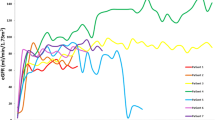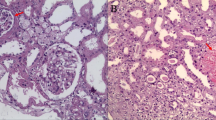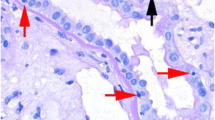Abstract
Background
Increased plasma cell infiltration in renal allograft biopsies is a rare finding associated with poor outcome in adult renal transplant recipients. The clinical impact of increased plasma cell infiltrates in paediatric renal transplant recipients (pRTR) remains unknown.
Methods
We conducted a retrospective case–control study from April 1996 to March 2014 comparing the outcome of pRTR with increased (>10 % of infiltrate) plasma cells in renal transplant biopsies to a control cohort of pRTR without increased plasma cell infiltration but similar grade of rejection according to Banff classification.
Results
Increased plasma cell infiltrates were present in 14 of 162 (9 %) reviewed pRTR aged 3.2–17.5 (median 13.4) years at time of transplantation. Compared with 14 pRTR renal transplant biopsies without significantly increased plasma cells, there were no significant differences in mismatch and baseline estimated glomerular filtration rate (eGFR). Plasma cells were present in case biopsies at a maximal density of 14–116 (median 33) plasma cells/HPF. Increased plasma cells were associated with decreased eGFR at biopsy (22 vs. 49 ml/min/1.73 m2; p < 0.001) and 4 weeks post-biopsy (26 vs. 56 ml/min/1.73 m2; p < 0.001) despite comparable eGFR 4 weeks prior to biopsy. Increased plasma cells were further associated with significantly increased frequency of renal allograft loss (71 % vs. 7 %; p < 0.001) at 0–27 (median 2) months after biopsy.
Conclusion
Increased plasma cell infiltrates in pRTR are uncommon but associated with significantly reduced renal allograft survival as well as significantly reduced allograft function in surviving grafts.



Similar content being viewed by others
Abbreviations
- AR:
-
Acute rejection
- DD:
-
Deceased donor
- EBV:
-
Epstein-Barr virus
- eGFR:
-
estimated glomerular filtration rate
- LRD:
-
Living related donor
- MMF:
-
Mycophenolate mofetil
- PCAR:
-
Plasma-cell-rich acute rejection
- pRTR:
-
Paediatric renal transplant recipient
- PTLD:
-
Posttransplant lymphoproliferative disorder
References
Solez K, Colvin RB, Racusen LC, Haas M, Sis B, Mengel M, Halloran PF, Baldwin W, Banfi G, Collins AB, Cosio F, David DS, Drachenberg C, Einecke G, Fogo AB, Gibson IW, Glotz D, Iskandar SS, Kraus E, Lerut E, Mannon RB, Mihatsch M, Nankivell BJ, Nickeleit V, Papadimitriou JC, Randhawa P, Regele H, Renaudin K, Roberts I, Seron D, Smith RN, Valente M (2008) Banff 07 classification of renal allograft pathology: updates and future directions. Am J Transplant 8(4):753–760
Desvaux D, Le Gouvello S, Pastural M, Abtahi M, Suberbielle C, Boeri N, Remy P, Salomon L, Lang P, Baron C (2004) Acute renal allograft rejections with major interstitial oedema and plasma cell-rich infiltrates: high gamma-interferon expression and poor clinical outcome. Nephrol Dial Transplant 19(4):933–939
Sun IO, Cho YH, Hong YA, Chung BH, Choi BS, Park GS, Choi YJ, Park CW, Kim YS, Yang CW (2013) Plasma cell-rich acute rejection with monoclonal gammopathy in a renal transplant recipient. Exp Clin Transplant 11(2):191–194
Meehan SM, Domer P, Josephson M, Donoghue M, Sadhu A, Ho LT, Aronson AJ, Thistlethwaite JR, Haas M (2001) The clinical and pathologic implications of plasmacytic infiltrates in percutaneous renal allograft biopsies. Hum Pathol 32(2):205–215
Charney DA, Nadasdy T, Lo AW, Racusen LC (1999) Plasma cell-rich acute renal allograft rejection. Transplantation 68(6):791–797
David-Neto E, Ribeiro DS, Ianhez LE, Palomino S, Saldanha LB, Arap S, Sabbaga E (1993) Acute interstitial nephritis of plasma cells: a new cause for renal allograft loss. Transplant Proc 25(1 Pt 2):897–899
Gartner V, Eigentler TK, Viebahn R (2006) Plasma cell-rich rejection processes in renal transplantation: morphology and prognostic relevance. Transplantation 81(7):986–991
Chikamoto H, Sugawara N, Akioka Y, Shimizu T, Horita S, Honda K, Moriyama T, Koike J, Yamaguchi Y, Hattori M (2012) Immunohistological study of a pediatric patient with plasma cell-rich acute rejection. Clin Transplant 26(Suppl 24):54–57
Shroff R, Rees L (2004) The posttransplant lymphoproliferative disorder-a literature review. Pediatr Nephrol 19(4):369–377
Suzuki T, Fukuzawa J, Furuya S, Yuzawa K, Aita K, Ohkohchi N, Nagata M (2005) Renal graft loss with plasma cell-rich acute rejection in cadaveric renal transplantation: a case report. Clin Transplant 19(Suppl 14):71–75
Gupta R, Sharma A, Mahanta PJ, Agarwal SK, Dinda AK (2012) Plasma cell-rich acute rejection of the renal allograft: A distinctive morphologic form of acute rejection? Indian J Nephrol 22(3):184–188
Yoshikawa M, Kitamura K, Ishimura T, Hara S, Fujisawa M, Nishi S (2015) A suspected case of plasma cell-rich acute renal transplant rejection associated with de novo donor-specific antibody. Nephrology (Carlton) 20 Suppl 2:66–69.
Marks SD (2012) New immunosuppressants in pediatric solid organ transplantation. Curr Opin Organ Transplant 17(5):503–508
Marks SD (2014) Treatment strategies to treat antibody-mediated rejection and to reduce donor-specific antibodies. Pediatr Transplant 18(5):417–419
Acknowledgments
This research was supported by the National Institute for Health Research Biomedical Research Centres at Great Ormond Street Hospital for Children NHS Foundation Trust, University College London, Guy’s and St Thomas’ NHS Foundation Trust and King’s College London. The views expressed are those of the author(s) and not necessarily those of the NHS, the NIHR or the Department of Health.
Author information
Authors and Affiliations
Corresponding author
Ethics declarations
Ethical approval was obtained for our renal transplant cohort from the Institute of Child Health and Great Ormond Street Hospital ethics committee.
Conflict of interest
The results presented in this paper have not been published previously in whole or part, except in abstract form. The authors declare that they have no conflict of interest.
Rights and permissions
About this article
Cite this article
Dufek, S., Khalil, A., Mamode, N. et al. Plasma-cell-rich infiltrates in paediatric renal transplant biopsies are associated with increased risk of renal allograft failure. Pediatr Nephrol 32, 679–684 (2017). https://doi.org/10.1007/s00467-016-3524-0
Received:
Revised:
Accepted:
Published:
Issue Date:
DOI: https://doi.org/10.1007/s00467-016-3524-0




